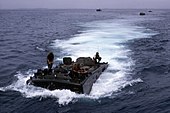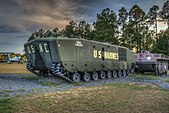| LVTP-5 | |
|---|---|
 An LVTP-5 on display at the USS Alabama (BB-60) memorial in Mobile, Alabama. The front of the vehicle is facing right in this picture. | |
| Type | Armored personnel carrier |
| Place of origin | United States |
| Service history | |
| In service | 1956–present |
| Used by | See Operators |
| Specifications | |
| Mass | 37.4 t |
| Length | 9.04 m (29 ft 8 in) |
| Width | 3.57 m (11 ft 9 in) |
| Height | 2.92 m (9 ft 7 in) |
| Crew | 3+34 passengers |
| Armor | 6-16 mm |
Main armament | .30 caliber MG/105mm howitzer(LVTP-6) |
| Engine | Continental LV-1790-1 V-12 gasoline 704 hp (525 kW) |
| Power/weight | 19 hp/tonne |
| Suspension | Torsilastic |
Operational range | 306 km (190 mi) road, 92 km (57 mi) water |
| Maximum speed | 48 km/h (30 mph), in water 11 km/h (6.8 mph) |
The LVTP-5 (landing vehicle, tracked, personnel 5) is a family of amphibious armored fighting vehicles used by the Philippine Marine Corps, the Republic of China Marine Corps, and, formerly, the United States Marine Corps. It was designed by the BorgWarner company and built by FMC (Food Machinery Corporation) along with a few other companies. It was first accepted into service in 1956. Some 1,124 basic units were produced, plus the specialist variants, and many saw action in the Vietnam War.



